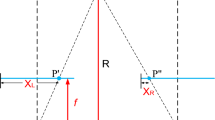Abstract
This article addresses the problem of measuring reliabily the absolute three-dimensional position of objects in an unknown and cluttered scene. It circumvents the limitations of a single sensor or single algorithm by using several range recovery techniques together, so that they cooperate in visual behaviors similar to those exhibited by the human visual system. Implemented visual behaviors include (i) aperture adjustment to vary depth of field and contrast, (ii) focus ranging followed by fixation, (iii) stereo ranging followed by focus ranging, and (iv) focus ranging followed by disparity prediction followed by focus ranging. The main contribution is a demonstration that two particular visual ranging processes—focusing and stereo—can cooperate to improve measurement reliability. The results of 75 experiments processing close to 3000 different object points lying at distances between 1 and 3 meters demonstrate that the computed range values are highly reliable.
Similar content being viewed by others
References
Abbott, A., and Ahuja, N. 1988. Surface reconstruction by dynamic integration of focus, camera vergence, and stereo,Proc. 2nd Intern. Conf. Comput. Vis., pp. 532–543, Tampa, FL, December.
Aloimonos, J. 1988. Visual shape computation,Proc. IEEE 76 (8):899–916.
Bajcsy, R. 1988. Active perception,Proc. IEEE 76 (8):996–1005.
Ballard, D. 1989. Reference frames for animate vision,Proc. 11th Intern. Joint Conf. Artif. Intell., pp. 1635–1641, Detroit.
Ballard, D. and Ozcandarli A. 1988. Eye fixation and early vision: Kinetic depth,Proc. 2nd Intern. Conf Comput. Vis., pp. 524–531, Tampa, FL.
Bond, A. and Gasser, L., eds. 1988.Readings in Distributed Artificial Intelligence. Morgan Kaufmann: San Mateo, CA.
Cardillo, J. and Sid-Ahmed, M. 1991. 3-D position sensing using a passive monocular vision system,IEEE Trans. Patt. Anal. Mach. Intell. 13 (8):809–812.
Clark, J. and Ferrier, N. 1988. Modal control of an attentive vision system,Proc. 2nd Intern. Conf. Comput. Vis., pp. 514–523, Tarpon Springs, FL.
Coombs, D. and Brown, C. 1990. Intelligent gaze control in binocular vision,Proc. Intern. Symp. Intell. Cont., pp. 239–245, Philadelphia, September.
Das, S. and Ahuja, N. 1990. Multiresolution image acquisition and surface reconstruction,Proc. IEEE Intern. Conf. Comput. Vis., pp. 485–488, Osaka, Japan, December.
Davis, R. and Smith, R. 1983. Negotiation as a metaphor for distributed problem solving,Artificial Intelligence 20:63–109.
Durfee, E., Lesser, V., and Corkill, D. 1989. Trends in cooperative distributed problem solving,IEEE Trans. Knowl. Data Engin. 1:63–83.
Ens, J. 1990.An Investigation of Methods for Determining Depth from Focus. Ph.D. thesis, University of British Columbia, July.
Fincham, E. and Walton, J. 1957. The reciprocal actions of accommodation and convergence,J. Physiology 137:488–508.
Geiger, D. and Yuille, A. 1987. Stereopsis and eye-movement,Proc. 1st Intern. Conf. Comput. Vis., pp. 306–314, London, June.
Gogel, W.C. 1961. Convergence as a cue to absolute distance,Psychology 52:287–301.
Graham, C. 1965. Visual space perception, C. Graham, ed.Vision and Visual Perception, Wiley: New York.
Grimson, W.E.L. 1981.From Images to Surface: A Computational Study of the Human Early Vision System. MIT Press: Cambridge, MA.
Grossman, P. 1987. Depth From Focus,Patt. Recog. Letts. 5:63–69, January.
Horn, B. 1968. Focusing. Master's thesis, MIT, May 1968; available as A.I. Memo No. 160.
Jarvis, R. 1976. Focus optimisation criteria for computer image processing,Microscope 24 (2):163–180.
Kersten, D. and Legge, G. 1983. Convergence accommodation,J. Opt. Soc. Amer. 73 (3):332–338.
Krishnan, V. and Stark, L. 1977. A heuristic model for the human vergence movement system,IEEE Trans. Biomed. Engineer. 24(1).
Krotkov, E. 1987. Focusing,Intern. J. Comput. Vis. 1(3):223–237.
Krotkov, E. 1989.Active Computer Vision by Cooperative Focus and Stereo. Springer-Verlag: New York.
Krotkov, E., Henriksen, K., and Kories, R. 1990. Stereo ranging with verging cameras,IEEE Trans. Patt. Anal. Mach. Intell. 12 (12):1200–1205.
Krotkov, E. and Kories, R. 1988. Adaptive control of cooperating sensors: Focus and stereo ranging with an agile camera system,Proc. Intern. Conf. Robotics Autom., pp. 548–553, Philadelphia, April.
Krotkov, E., Summers, J.F., and Fuma, F. 1988. An agile stereo camera system for flexible image acquisition,IEEE J. Robot. Autom. 4(l):108–113.
Lesser, V. and Corkill, D. 1981. Functionally-accurate, cooperative distributed systems,IEEE Trans. Syst. Man, Cybern. 11(1):81–96.
Lesser, V. and Corkill, D. 1983. The distributed vehicle monitoring testbed: A tool for investigating distributed problem solving networks,AI Magazine 4(3):15–33.
Miles, F., Judge, S., and Optican, L. 1987. Optically induced changes in the couplings between vergence and accommodation,J. Neuro-science 7&8:2576–2589.
Nayar, S. and Nakagawa, Y. 1990. Shape from focus: An effective approach for rough surfaces,Proc. IEEE Intern. Conf. Robot. Autom., pp. 218–225, Cincinnati, May.
Olson, T. and Coombs, D. 1991. Real-time vergence control for binocular robots,Intern. J. Comput. Vis. 7(1):67–89.
Pentland, A. 1987. A new sense for depth of field,IEEE Trans. Patt. Anal. Mach. Intell. 9(4):523–531.
Schor, C. 1979. The relationship between fusional vergence eye movements and fixation disparity,Vision Research 19(12):1359–1367.
Shmuel, A. and Werman, M. 1990. Active vision: 3D from an image sequence,Proc. 10th Intern. Conf. Patt. Recog., pp. 48–54, Atlantic City, June.
Smith, R. and Davis, R. 1981. Frameworks for cooperation in distributed problem solving,IEEE Trans. Syst. Man, Cybern., 11:61–70.
Sperling, G. 1970. Binocular vision: A physical and a neural theory,Amer. J. Psych. 83:461–534.
Subbarao, M. 1988. Parallel depth recovery by changing camera parameters,Proc. IEEE Intern. Conf. Comput. Vis., pp. 149–155, Tarpon Springs, FL.
Swain, J. and Stricker, M. eds. 1991.Promising Directions in Active Vision, available as University of Chicago Tech. Rep. CS 91-27, November.
Tenenbaum, J. 1970.Accommodation in Computer Vision. Ph.D. thesis, Stanford University, November.
Westheimer, G. 1976. Oculomotor control: The vergence system. In R. Monty and J. Senders, eds.,Eye Movements and Psychological Processes, pp. 55–64, Erlbaum: Hillsdale, NJ.
Whaite, P. and Ferrie, F. 1991. From uncertainty to visual exploration,IEEE Trans. Patt. Anal. Mach. Intell. 13(10):1038–1049.
Zhang, C. 1992. Cooperation under uncertainty in distributed expert systems,Artificial Intelligence 56:21–69.
Author information
Authors and Affiliations
Rights and permissions
About this article
Cite this article
Krotkov, E., Bajcsy, R. Active vision for reliable ranging: Cooperating focus, stereo, and vergence. Int J Comput Vision 11, 187–203 (1993). https://doi.org/10.1007/BF01469228
Received:
Revised:
Issue Date:
DOI: https://doi.org/10.1007/BF01469228




